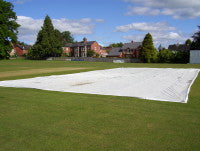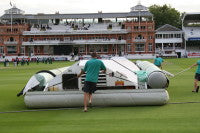Cricket covers can mean profit for clubs
 Put simply, there are still far too many cricket clubs out there that don't have a pitch cover. That's fine, if you don't mind belonging to, or supporting, a club which is rained off as often as play is on. Or, if you don't mind cancelling or rescheduling a long awaited match. But, who wants to do that with all the associated extra time and costs that can bring, let alone a congested fixtures list?
Put simply, there are still far too many cricket clubs out there that don't have a pitch cover. That's fine, if you don't mind belonging to, or supporting, a club which is rained off as often as play is on. Or, if you don't mind cancelling or rescheduling a long awaited match. But, who wants to do that with all the associated extra time and costs that can bring, let alone a congested fixtures list?
It's hard enough arranging the season with all the paperwork and planning it involves. So, if you want more time on the pitch, or watching the match and celebrating (or commiserating) in the bar after the game, then you really ought to make sure your club's pitch is playworthy as often as possible.
No longer should a poorly prepared ground be tolerated in a league where expectations and commitment is high. A few years back, the FA brought in new regulations which saw football league clubs having to ensure that adequate frost protection was in place. This quickly cascaded a higher standard to non league grounds who, in turn, made the playability of their pitches a top priority.
To some extent, the same could be applied to cricket. The majority of higher quality sides now have pitch protection in place as standard and, yet, far too many of the smaller clubs are still missing matches simply because they think they can't afford a cover. The reality, however, is that a cover can now cost as little as a night's takings from the bar.
Missing matches because the ground can't be played on could cost the club far more than the cost of a cover. It's also about reputation. In a professional outfit, it is a necessity these days to take visible and transparent steps towards looking after your ground, so that the players, public, media, investors and directors can see that the club is being run professionally.
 There is a gap appearing in the non league fixture list between those that have taken the step towards protecting their pitches and those that have not - with the latter increasingly opening themselves to criticism for having unplayable grounds at the first sign of rain.
There is a gap appearing in the non league fixture list between those that have taken the step towards protecting their pitches and those that have not - with the latter increasingly opening themselves to criticism for having unplayable grounds at the first sign of rain.
The good news is that the cost of cricket covers has also come down, and they are now even more affordable, providing a quicker return on investment. Five years ago, they weren't cheap, but the price has reduced dramatically, as all the retailers are trying to think outside the market and price products competitively. Innovations, such as lightweight and breathable covers, have also come to the fore as they allow air to the ground, which was previously an issue for some groundsmen.
As a manufacturer, we are always looking into what materials and designs can be used to improve performance and, in our case, we are pulling on our forty years of experience to create our own bespoke covers. No-one is trying to reinvent the wheel, the key is listening to customers who want covers to last as long as possible and give them a great return on investment.
To my mind, groundsmen need to make the case for a cover in terms of value, not only to the club's takings but also the value of protecting the wicket. If there is a match, then money will be spent behind the bar. If no match can be played, then cricket clubs are reducing their potential income -  they really should be recognising the value of protecting the ground.
they really should be recognising the value of protecting the ground.
Once you have made the initial investment, that's the end, as there is no further financial outlay, making it an easy budgeting decision. If your ground isn't covered, how many matches could you lose out on? An average cricket club receives £200-£300 in fees and bar spend from one match. Some of that goes to the club to generate income. It's pretty simple maths - you don't receive any of that money for being called off.
So, what should cricket clubs be thinking if they want to buy a cover?
Lower to mid-level clubs have to understand what are their greatest needs regarding pitch protection. For example, do you want to protect one wicket or the whole square? Do you want the grass to breathe or is a short term solution required? How big is the pitch and is it on a slope? Have these questions answered before you buy, as the most expensive cover may not be the best one for your ground.
Another consideration is staffing. Clubs must think about what labour is available to them when covering the ground, and how quickly they need to get a ground covered when rain comes. Some covers can be mobilised within less than minute - which also means they can be removed just as quickly so play can resume.
What's the right cover?
The 'ultimate' in cricket ground covering is the Hover Cover. It is fast and reliable, carries the side sheets and bowlers' run-up covers, and is a great sponsorship  opportunity to boot. The Mark 3 set of mobile cricket covers are now available and are lightweight, easy to manoeuvre and very competitively priced.
opportunity to boot. The Mark 3 set of mobile cricket covers are now available and are lightweight, easy to manoeuvre and very competitively priced.
Alternatively, three other types of cricket flat sheet are offered, ranging from Test ground standard to the more modestly priced club and school level equivalents. These are lightweight, UV stabilised and a tried and tested product.
Don't get mis-sold; the best way to protect against this is to fully understand why you want, and what you need from the product, and convey this to the company you choose to buy from.
Another thing a groundsman should consider is the local wildlife. For example, seaside towns require a certain type of cover, as seagulls peck at them and make holes. Some covers attract or repel them and a heavier material would work best. In more rural areas, foxes scrape at or munch covers, so it's important to think about every eventuality.
If you ask yourself and the retailers the right questions, you could end up buying the cheapest option which adequately addresses your and your club's needs.
Many companies make bespoke covers, taking into account an individual club and their ground's needs. If this is right for your club, let them know so that they are able to answer problems you may have, and design a solution around those problems.
Cover maintenance
 Purchasing a pitch cover is an investment. Therefore, it makes sense to treat it with respect, like you would any other investment. By looking after the cover you will get a longer life and greater use out of it, allowing you to protect the ground for longer.
Purchasing a pitch cover is an investment. Therefore, it makes sense to treat it with respect, like you would any other investment. By looking after the cover you will get a longer life and greater use out of it, allowing you to protect the ground for longer.
When storing it, ensure you fold or roll it tidily away, rather than bundle it up, as that can trap moisture. Also, don't leave it stuffed in a shed where it can attract mould, and never store it away when it's wet. Finally, keep the cover away from where players run to ensure it isn't damaged with studs or cause a tripping hazard. Simply, if you look after your cover, you won't need to replace it nearly as quickly.
When it comes to pitch cover care, it's clear that a little investment can bring some very happy returns, both financially and in terms of a clubs credibility. But, before buying, make sure your get the best advice and, if your supplier doesn't offer that, maybe look elsewhere.
